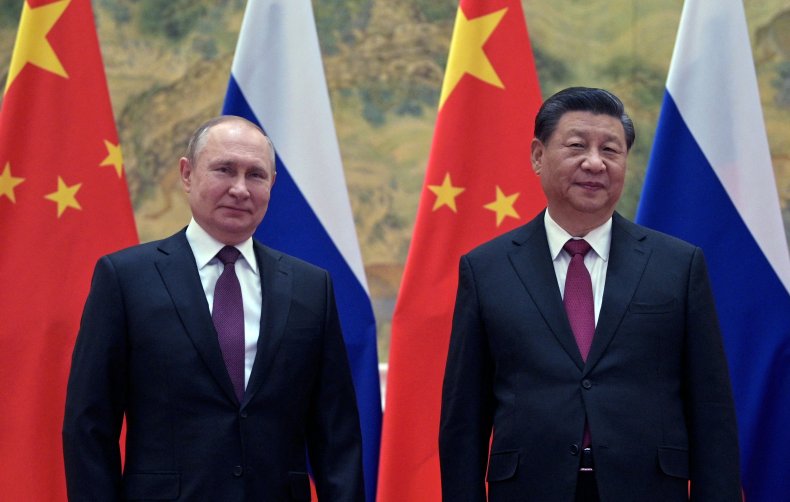Putin Scraps Arms Treaty, China and Russia Threaten To Use Nukes | Opinion
Russian President Vladimir Putin on Tuesday announced Russia's suspension of its participation in the New Strategic Arms Reduction Treaty.
New START, as the landmark agreement is known, is the only remaining arms control agreement between the United States and Russia. The pact generally limits the U.S. and Russia to 1,550 deployed strategic warheads each.
"With today's decision on New START, the whole arms control architecture has been dismantled," said Jens Stoltenberg, NATO's secretary general, immediately after Putin's announcement, made in an address to Russian lawmakers.
The Russian leader did not formally withdraw from the pact. He did, however, threaten to resume testing nuclear weapons.
Secretary of State Antony Blinken told reporters that "we remain ready to talk about strategic arms limitations at any time with Russia, irrespective of anything else going on in the world or in our relationship."
What's there to talk about? The treaty is already a dead letter.
Russia was openly violating its inspection provisions. Moscow had not allowed the resumption of 18 annual on-site inspections, which were "temporarily" suspended during the COVID-19 pandemic. In addition, Russia "unilaterally postponed" meetings of a commission monitoring compliance. On January 31, the State Department confirmed that Russia was not adhering to New START.
There's no point talking with Putin about arms control. For instance, China is not a party to New START and has rebuffed all American attempts to discuss arms control or disclose the number of its warheads. As the Hudson Institute's Peter Huessy told Newsweek, "No deal to limit China's arsenal is possible if the size of that arsenal is unknown."
Moreover, Beijing and Moscow are forming a quasi-alliance. They issued a 5,300-word joint statement on February 4 of last year, proclaiming their "no limits" partnership, and the pair regularly conducts joint military exercises. American war planners, therefore, have to assume that China and Russia will gang up on the U.S. These two militant powers could soon have a combined nuke arsenal twice the size of America's.
Although arms control advocates argue that countries need only a few hundred warheads to deter attacks, a great disparity in numbers could invite nuclear adventurism. Washington, in short, should not extend New START without China joining the pact.
Moreover, New START suffers from another major flaw: It does not include Russia's large arsenal of tactical nukes. Huessy says that without inclusion of these weapons, a new New START would be "a very bad deal."
What should be done? Connor Murray, a scholar at the Washington, D.C.-based Center for Arms Control and Non-Proliferation, argued at the beginning of this month for negotiations to extend the pact—it is set to expire February 5, 2026—by inking a "political agreement" not requiring Senate approval.

Huessy, on the other hand, calls for more nukes to get to fewer, something that worked during the later stages of the Cold War. "The U.S. has to build across the board to have any leverage to strike a deal," he argues. "Substituting 'dialogue' doesn't cut it. Reagan's 'Peace Through Strength' strategy and push for real reductions changed the strategic environment, won the Cold War, and ended the Soviet empire."
Instead of trying to obtain security by reducing the number of nuclear weapons, America's main effort should be rebuilding defenses. At the moment, the U.S. is blind to the nuclear attacks enemies could soon launch.
During the Cold War, the U.S. built the DEW—Distant Early Warning—Line, from the Aleutians in the west to Iceland in the east, to detect Soviet missiles coming from the north. No similar line was built for missiles coming from the south.
Today, the primary radars peering south, James Fanell of the Switzerland-based Geneva Centre for Security Policy tells Newsweek, are two "relocatable" installations, currently based in Texas and Virginia, used primarily to catch drug smugglers.
China's hypersonic glide vehicle, tested in August 2021, can drop out of space and hit the U.S. from southerly directions, notes Fanell, a former director of Intelligence and Information Operations of the U.S. Pacific Fleet. Americans might not even see such an attack until moments before detonation.
"America must build a southern DEW Line, sooner rather than later," he says. Fanell also makes the point that the Chinese spy balloon that entered U.S. territorial airspace in the Aleutians on January 28 looks like it was trying to gather intelligence on America's northern radars.
America's emphasis, therefore, must be patching and upgrading its aging detection systems rather than trying to talk to militant Russia and China.
"If the United States and the Soviet Union were able to agree to limits on their nuclear arsenals during the peak of the Cold War, the United States and Russia can do the same today," writes Murray.
Perhaps not. That global struggle was decades old by the time Washington and Moscow were able to hammer out arms control deals. By then, the two adversaries had achieved far more stable relations than they have today. Now, the world is not only in the middle of a war—it is also passing an historic inflection point, transitioning from a period of general calm to one of constant turbulence.
At this moment, no arms control deal is either possible or advisable, especially because during the past year both Russia and China have been making threats to preemptively use nuclear weapons against America and its partners.
Global arms control is dead. Putin did everyone a favor by making it clear that it's time for America to rebuild defenses against a wider war Beijing and Moscow are preparing to fight.
Gordon G. Chang is the author of The Coming Collapse of China. Follow him on Twitter: @GordonGChang.
The views expressed in this article are the writer's own.

